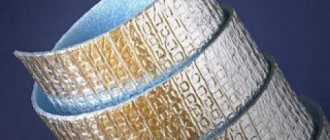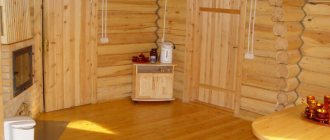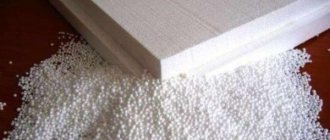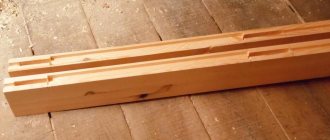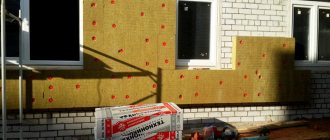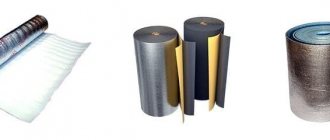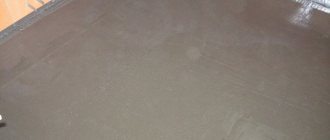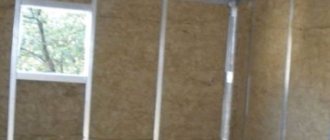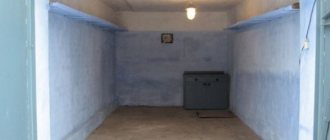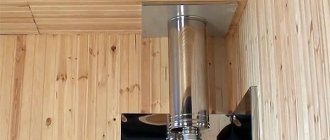Historically, the least attention was paid to the floors in bathhouses. This was explained by the fact that there was no centralized sewage system, and all the water flowed through the floor covering into the ground. Constant moisture would lead to the appearance of bacteria, fungi and an unpleasant odor on the insulation, so the insulation for the bathhouse floor was simply not used.
Photo of the final stage of insulation - tiling
Nowadays, when all permanent buildings have a connection to central sanitary systems, experts advise carrying out insulation work after all activities with the log house have been completed:
- Roof installation;
- Connecting the drainage system;
- Installation of doors and windows.
At the moment, such buildings are not just places for hygiene and relaxation, but also complex engineering structures, which are often installed on piles. Such structures must be adapted to work at high temperatures and high humidity levels.
Floors in the bathhouse
The service life of a bathhouse is related to the quality of its constituent elements. The most common floors are clay and wood. The timber may not withstand constant changes in dampness and temperature, and the clay first absorbs moisture and then cracks when it dries.
It becomes obvious that materials that are safe for human health and are good heat insulators quickly become unusable. In such conditions, laminate or linoleum can be used for a long time, but due to its synthetic component this is unacceptable.
If you are wondering how to insulate the floor in the dressing room, then it is better to take a wooden board, and for the steam room the optimal solution would be concrete. The latter has high strength and does not enter into harmful chemical reactions when exposed to atmospheric influences.
But in order for floors made of concrete or timber to have good thermal conductivity, it is necessary to take measures to install thermal insulation.
Insulation of concrete floor
The building materials market offers many options for building an insulating layer with your own hands. Depending on the budget of the work, they may also vary.
There are two most effective methods of insulation:
- Using perlite;
- Using polystyrene foam or expanded polystyrene.
Insulation using perlite
Perlite is a modern material that is of volcanic origin. It has excellent thermal insulation properties, and also does not react with any substances and is not subject to combustion.
Important. Perlite itself is a lightweight material; it can fly apart in light gusts of wind. Therefore, when working with it, it is necessary to avoid drafts - close doors and windows.
As for working with perlite, first it is mixed with water, but you need to take half as much liquid. Next, cement is added to the resulting mixture. This solution must be continuously stirred until excess water begins to appear on its surface.
Concrete floor in the dressing room
After this, the resulting solution is laid out on the floor, and it dries within a week, after which it is covered with concrete again.
The main advantages of such multilayer thermal insulation are:
Foam insulation
The main advantage of this method is its simplicity. The foam itself is low cost, light weight and easy to process. In addition, its slabs are almost completely hygroscopic (do not absorb water) and do not rot.
- This kind of floor insulation in a bathhouse is installed mainly in two layers;
- The joints formed between them are sealed with polyurethane foam or plugged with scraps of this material;
- A screed is laid on top of the heat insulator in question using reinforcement;
- Next, when the structure is completely dry, it is covered with ceramic tiles.
Advice. If you decide to make the insulation yourself, then before laying the foam, apply an additional layer of waterproofing to the concrete coating; it will prevent the penetration of moisture.
Tips for choosing insulation
The right choice of insulation is the key to success
The modern market offers a huge number of insulation materials. They differ from each other not only in their technical characteristics, but also in cost. However, you should not rely on the latter when choosing the best option.
The choice of insulation must be made based on:
- Type of flooring. Concrete floors are insulated with penoplex, expanded clay or perlite. The wooden floor is made of penoplex, as this is the only material that does not absorb moisture at all. It is undesirable to lay insulation with a fiber or open cellular structure under it, for example, expanded clay, since in this case it will be necessary to equip a reinforced layer of waterproofing. Penoplex can be replaced with foamed polymers - ecowool or Aisinin foam. Being light in weight, they retain heat well. However, electric, infrared or water heating can be installed under both concrete and wooden floors.
- The premises in which it will be installed. Organic insulation is suitable only for use in rest rooms or in the dressing room, since even treatment with fire retardants does not make them resistant to high temperatures.
- Personal wishes for safety - insulation can be organic and of plant or animal origin (felt, tow, cellulose) and inorganic (foam plastic, mineral wool and glass wool). The latter are produced through the processing of minerals and are characterized by resistance to high temperatures. However, they are inferior in environmental friendliness to organic insulation.
In addition, you need to pay attention to the specific gravity of the insulation itself. A good insulation is one that does not create additional load on the foundation
We insulate timber floors
For baths that are located on stilts, insulation is also protection that can extend their service life. Therefore, special attention must be paid to its quality and reliability; the installation instructions and other recommendations must be followed.
It should be noted that the manufacture of thermal insulation for wooden floors should consist of the following points:
- The logs are laid on the subfloor;
- The space formed between them is filled with insulation - expanded polystyrene, expanded clay or mineral wool;
- Work is underway to install waterproofing;
- The floorboard is being laid.
Important. When laying boards in this type of bathhouse, you need to maintain a slight slope so that the water drains.
Recommendations
Attention should also be paid to floors that are fixed to pile foundations. Stages of work:
- Tie the pile heads together with special screw beams.
- Lay a layer of waterproofing on a wooden base made of beams.
- Place rough timbers on the lower sides of the beams.
- Lay sheets of thermal insulation and cover them with waterproofing film.
- Apply a finishing coat.
It is important not to confuse the method of laying the waterproofing film. Instructions are included on the packaging.
Concrete floors in bathhouses need to be insulated. If this is not done, they will be very cold despite the heating of the rooms. For thermal insulation, you need to choose one of several types of materials. It is important to take into account the features of insulation when carrying out work independently.
Types of expanded clay
Expanded clay is represented by round granules with a porous structure made of baked clay.
There are three variations of it:
- Expanded clay sand
. Available in grain sizes from 0.1 to 10 mm. It is used as a filler in mortars and as a backfill when insulating bathhouse ceilings up to 50 mm thick. Price - from 150 rubles per bag.
Expanded clay gravel
. Each granule has a size of 1 to 2 cm. It is used to insulate the entire structure. The cost is about 200 rubles per bag.
- Expanded clay-crushed stone
. The fractions have a size of 2-4 cm. They are often mixed with gravel to compact the mixture. Price - about 200 rubles per bag.
Specifications
The material parameters are established by GOST 9757-90, which regulates the quality of porous building materials
Some indicators are not regulated, but still remain an important characteristic. Let's take a closer look at the main properties of expanded clay
- Factional composition. In total, three fractions of material have been established, having a size range of 5-10 mm, 10-20 mm, 20-40 mm. A separate category includes fractions that are rarely used in construction work. These include expanded clay granules and crushed stone with sizes from 2.5 to 10 mm, as well as a wide mixed fraction from 5 to 20 mm. Thermal insulating expanded clay layers used in the form of bulk mass are a mixture of all fractions - from 5 to 40 mm. This is due to the need to fill voids in the heat-insulating layer, which increases the rigidity of the structure and eliminates convection air currents.
- Expanded clay grades by bulk density (volumetric bulk density). A total of seven values are established: up to 250 kg/m3 - grade 250, from 250 to 300 kg/m3 - grade 300, similarly - grades 350, 400, 450, 500, 600. Grades 700 and 800 are not produced for general sale and are produced only upon agreement with the consumer. True density (true volumetric weight) is 1.5-2 times greater than bulk density. This parameter characterizes the density of the material without taking into account the gaps between granules or fragments of the material;
- Expanded clay grades by strength. For gravel, there are 13 grades, differing in strength when compressed in a cylinder. For crushed stone, 11 grades are standardized, having the same designations as gravel grades. The strength of crushed stone and gravel of the same brand varies. Thus, for grade P100, the compressive strength of gravel is from 2.0 to 2.5 MPa, while crushed stone is from 1.2 to 1.6 MPa. There is a relationship between expanded clay grades in terms of density and strength - an increase in density leads to an increase in strength. The relationship between brands is also regulated by the GOST 9757-90 standard, which eliminates the production of low-quality high-density expanded clay that breaks down under light load.
- Compaction coefficient is a value agreed with the consumer, which does not exceed 1.15 and is used to take into account the compaction of the expanded clay mass as a result of transportation or caking. The use of the coefficient is associated with frequent shipment of material by bulk volume, which is convenient for the sale of large quantities.
- Thermal conductivity is the most important parameter characterizing thermal insulation properties. For expanded clay, the thermal conductivity coefficient ranges from 0.10 to 0.18 W/(m?°C). The range of values is quite narrow, which indicates the high thermal insulation properties of the material. With increasing density, the thermal conductivity coefficient increases. This is due to a decrease in the number and volume of pores containing the main heat insulator - air.
- Water absorption is an important parameter showing the behavior of a material when exposed to water. Expanded clay is a relatively resistant material and is characterized by a water absorption value of 8-20%.
- Sound insulation - like most thermal insulation components, expanded clay has increased sound insulation. The best results are achieved when soundproofing a wooden floor, in which expanded clay acts as a layer between the outer part of the floor and the interfloor slab.
- Frost resistance - due to low water absorption and clay, which is the basis of the material, expanded clay has fairly high frost-resistant properties. Numerical values are not standardized by standards, since expanded clay is frost-resistant “by default.” Only the indicators of building stones that contain expanded clay - expanded clay blocks - are standardized.
The following video will tell you how to calculate how many cubes of expanded clay in a bag:
Features of bathhouse thermal insulation with expanded clay
Expanded clay is a natural material, which means it is environmentally friendly. However, environmental friendliness is not the only advantage of this heat insulator. It is very popular when insulating a bath due to its many advantages, such as:
- Cheap
. Compared to most synthetic insulation materials, expanded clay has a low cost.
Durability
. The material does not emit toxic fumes and does not decompose or rot.
High thermal insulation properties
. The thermal conductivity of expanded clay is 0.12 W/mK, which is especially important when used in a bathhouse, where high temperatures are considered the norm.
Fire resistance
. Expanded clay is a heat-resistant material. It does not burn or melt under high temperatures.
Light weight
. This allows it to be used to insulate the ceiling of a bathhouse.
Pest resistance
. Expanded clay is not attractive to insects and rodents.
. Using expanded clay you can not only insulate, but also level the surface. In addition, it can be used in conjunction with heated floors.
As for the disadvantages of using the material, among them we can highlight the labor-intensive process of thermal insulation. In addition, when using expanded clay to insulate a bathhouse, it is necessary to pay special attention to vapor and waterproofing.
Before proceeding directly to thermal insulation work, calculate the amount of expanded clay that is required to insulate the bathhouse. It is better to purchase it with a reserve, since fragile granules may break during transportation. It is advisable to take material with granules of different sizes. This will allow it to form the most dense backfill and reduce further subsidence.
Pay special attention to vapor and waterproofing. The best option is Izospan or aluminum foil. But it is not recommended to use roofing felt. It is flammable and can become wet under the influence of high temperature and humidity.
Advantages and disadvantages
Granular bulk material has many advantages. The main thing, perhaps, is the ratio of quality and cost indicators. Unfortunately, it was not without its drawbacks. Therefore, you can hear opinions for and against its use.
The undeniable advantages of expanded clay:
- Good thermal insulation properties. The clay from which expanded clay is made is itself capable of retaining heat. After foaming, air-filled pores are formed in it, due to which the thermal conductivity is significantly reduced.
- Light weight. Despite the fact that when insulating building structures, expanded clay is poured in a fairly thick layer, the load on the base from its weight is small.
- Easy to use. Working with the material does not require special skills or the use of special expensive equipment.
- Non-flammability. Expanded clay does not burn. When heated, it does not release toxins or unpleasant odors.
- Unsuitable for rodents and insects. The insulation will not be destroyed by the invasion of various living creatures.

- Resistant to heat and chemicals. The granules will not collapse in heat or frost, and will not lose their thermal insulation properties when interacting with household chemicals.
- Soundproofing. Along with the properties of insulation, expanded clay significantly reduces noise penetration.
- Environmentally friendly. Absolutely harmless to people and pets.
- Durability. Expanded clay pillow, if the installation rules are followed, can last a whole century!
The disadvantages of insulation appear during installation. To achieve the desired result, the granules are poured in a thick layer - from 10 to 40 cm. In this case, the ceiling becomes much closer to the floor, which is not always pleasant, and sometimes simply unacceptable.
If the hard shell is missing or damaged, moisture penetrates into the granules. Raw expanded clay is unsuitable for use, and it takes a very long time to dry. To prevent the absorption of moisture by the insulation during installation, additional materials are used: waterproofing from below and vapor barrier on top of the heat insulator. Failure to follow the rules will result in moisture penetrating into the granules. Then the expanded clay will get wet, its weight will increase, and it will sag in places. The beneficial properties will disappear.

Bathhouse insulation technology with expanded clay
The porous structure of the heat insulator granules significantly increases its thermal insulation characteristics. In order for energy saving to be as effective as possible, you need to correctly select not only the main insulation, but also other insulators.
Instructions for insulating a bathhouse ceiling with expanded clay
When calculating the amount of material for thermal insulation of the ceiling in the bathhouse, keep in mind that the layer should be 20 cm or more. Insulation is carried out from the attic side. If desired, you can mix expanded clay in the form of sand and gravel. This will make the backfill as dense as possible.
We carry out the work in the following sequence:
We overlap the vapor barrier membrane by 12-15 cm. If aluminum foil is used, the reflective surface should be located inside the room.
Carefully seal the joints with metallized tape. If you decide to use roofing felt, seal the joints with rubber-bitumen mastic.
We vapor barrier the rafters and chimney above the level of the future backfill. We attach the material using masking tape or a construction stapler.
Make a layer of crushed clay about 10 cm and compact it thoroughly. This is necessary for additional thermal insulation.
We fill in the expanded clay and level it over the surface.
Features of floor insulation in a bathhouse with expanded clay
The thermal insulation of the flooring in the steam room must be taken care of at the stage of its construction or major repairs. It is also important to take into account the maximum permissible load when calculating the layer thickness.
During the process we follow these instructions:
- We spread the waterproofing bitumen material on the concrete covering with an overlap of 10 cm. The overlap on the walls should be about 15 cm.
Using alabaster, we attach “beacons” around the perimeter of the floor, which will show the thickness and evenness of the layer.
When filling between wooden joists, care must be taken to pre-treat them with antiseptic compounds.
We fill in expanded clay with a height of 15-20 cm. In this case, it is also better to use a mixture of fractions of different sizes.
We water the backfill with “cement laitance” (a mixture of cement, water and primer). This is necessary so that the individual granules “adhere” to each other.
A day later, we install a metal reinforcing mesh on top to give the structure additional rigidity and strength.
Fill it with a cement-sand screed about 3 cm thick and wait for it to dry completely. Please note that the drying of the screed can be determined with a glass jar. It must be placed with its neck to the floor. If it does not fog up, then you can begin further work.
We fix the waterproofing material.
If you decide to insulate with expanded clay over the ground in a bathhouse, then its layer will be significantly thicker (about 30-35 cm), which will raise the height of the floor. This must be taken into account at the stage of designing the height of the walls of the bathhouse.
Specifics of insulating bath walls with expanded clay
Bulk materials can only be used for thermal insulation of brick walls of buildings. This process must be thought through during construction.
A brick bathhouse is insulated with expanded clay in the following order:
- We are building the first outer wall using brickwork, half a brick thick.
Inside, at a distance of 35 cm, we lay out a second wall of the same thickness in parallel.
We install jumpers inside every 10 cm.
We fill the expanded clay with a layer of 20-40 cm and compact it thoroughly.
We pour the cement mixture to “set” the individual fractions.
Principles of work
After familiarizing yourself with insulation materials, you can begin to insulate yourself. To do this, you need to prepare tools, consumables, draw up a project, and carry out the work.
sharp knife;
- roofing felt sheets;
- ruler, tape measure, building level;
- sand, cement, water, container for mixing the solution;
- electric drill, whisk attachment;
- insulation;
- waterproofing.
The amount of consumables depends on the area of the room. On the thermal insulation material, the manufacturer writes how many square meters the package is enough for.
To properly insulate bath rooms, you need to prepare the base. To do this, you need to take into account some nuances:
- Insulation must be carried out at the main stages of building construction. If this has not been done, you will have to dismantle the floor covering and pour a new screed.
- The base must be smooth, without bumps, cracks, or chips. To level it, you need to pour fresh screed along the beacons.
- It is not recommended to cover the materials that will cover the walls and the floor in the steam room with antiseptics. They can release harmful substances when heated strongly.
The insulation process varies depending on the type of room.
Execution of work:
- When the concrete base is ready, it is necessary to create a frame to secure the thermal insulation. To do this, a rough base of bars should be filled on top of the lags. Intermediate slats are laid out between the beams.
- The next stage is laying the waterproofing.
- Insulation can be installed on top of the waterproofing material.
- The top of the heat insulator is covered with another layer of waterproofing.
The last stage of construction is laying finishing boards.
Execution of work:
- Preparing the base.
- Leveling the concrete slab.
- Laying waterproofing.
- Distribution of slab or bulk insulation.
- Laying reinforcing mesh. It can be knitted from individual metal rods.
If you only want to step on a heated floor, you can install a special system for forced heating of floor coverings. You need to choose what it will be - electric, water, infrared. Next, you need to purchase consumables and begin construction work. Main stages:
- Prepare the base and level the subfloor.
- Lay a layer of thermal insulation.
- Attach a reinforcing mesh over the heat insulator.
- Attach the system to the mesh.
- Connect the structure to a general electrical network or water supply system. Check functionality.
- Fill the subfloor.
- Wait for the concrete to dry.
All that remains is to do the finishing touches.
Floor insulation with expanded clay
On the territory of Russia there is no such housing, bathhouse or other domestic building that would not need to be insulated, since in most of the territory of our country the temperature in winter drops much below the zero mark of the thermometer. Perhaps the most important object where thermal insulation is used indoors is the floor. A warm, cold-resistant floor is the key to the health of the residents of the house, and it’s simply pleasant to walk on a warm floor rather than on ice tiles.
Using expanded clay you can significantly reduce heat loss in your home through the floor.
Conclusion
Despite the fact that croaker is only a waste product for sawmills, this material can be used in many different ways. After all, it consists of wood, which means that in certain conditions it can effectively replace more expensive lumber.
After reading the article and watching photos and videos, you learned how to build a country house, barn, garage or bathhouse with your own hands from slab, how to use it in cladding, making furniture and various products, what else can be made from this material, and how to build a business.
Sources
- https://strofix.ru/bath-houses-and-saunas/61-stroim-banyu-iz-podruchnyh-materialov.html
- https://vbanepar.ru/banya-karkasnaya-svoimi-rukami.html
- https://texnotoys.ru/materialy/banya-zasypnaya-opilkami.html
- https://parilochka.com/banya/iz-dosok
- https://iobogrev.ru/zasypnaja-banja-iz-opilok-svoimi-rukami

